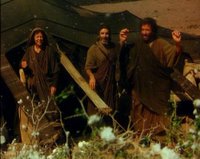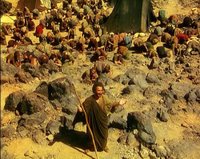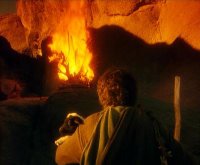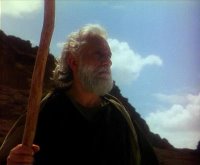Giving of the Ten Commandments
 My church is looking at the Ten Commandments at the moment, so I got asked to dig out some clips of Moses receiving the commandments. I looked at the following five which are probably the best crafted of those available:
My church is looking at the Ten Commandments at the moment, so I got asked to dig out some clips of Moses receiving the commandments. I looked at the following five which are probably the best crafted of those available:The Ten Commandments (1923)As well as being the best clips they are probably the most widely known. The other popular Moses film that is not on the list is obviously The Prince of Egypt, but this only really shows a brief shot of Moses holding the commandments right before the credits roll. Likewise there is no equivalent scene in 1974's Moses und Aron For the record I could also have included clips from the following:
The Ten Commandments (1956)
Moses the Lawgiver (1975)
Moses (1996)
Ten Commmandments (2006)
Green Pastures (1936)...not to mention a whole host of cartoons.
The Living Bible - Moses, Leader of God's People (1958)
Greatest Heroes of the Bible - The Ten Commandments (1979)
History of the World Part 1 (1981)
The Ten Commandments: The Musical (2006)
Ten Commandments (2007)
Anyway, for anyone interested in repeating the exercise elsewhere, here are the start and end places/times of the clips I used - the clip length, and the version that I used. In most cases these are region 2, but I imagine the difference will be very slight, particularly as the DVD releases for the first two are identical regardless of the regional code. Links are to previous posts on each film. I've also added the leading actor's name and a few comments.
 The Ten Commandments (1923)
The Ten Commandments (1923)Ten Commandments (1956) 50th Anniversary Collection – region 2
Disc 3 - Chapter 6; 35:05 – 42:48 [7:43 minutes]
Moses played by Theodore Roberts
This is the oldest of those available, and, for those unused to silent films, the style takes a bit of getting used to. Note the age of Moses here, and also that DeMille's citations are from Exodus 31 and 32 rather than the first account of the giving of the commandments in Exodus 19 and 20.
The Ten Commandments (1956)
Ten Commandments (1956) 50th Anniversary Collection – region 2
Disc 2 – Chapter 15; 73:12 – 78:45 [4:30 minutes]
Moses played by Charlton Heston
This is, obviously the most famous version, but it's utterly reliant on DeMille's earlier version. The streak of fire writing the commandments is fresh, but otherwise it's just a remake. Note how in both examples Moses receives the commandments at the top of the mountain, and whilst commandments 1 and 2 are being broken (not that the people would have known given this film's chronology!)
Moses the Lawgiver (1975)
Network/Granada Ventures – Region 2
Disc 2 – Chapter 3; 10:48 – 15:00 [4:12 minutes]
Moses played by Burt Lancaster
This is perhaps the most controversial version of these events, but it's relatively accurate to the accounts in Exodus. The clip ends with Moses on his way up the mountain with the tablets already under his arm, with the people having already agreed. An earlier scene shows Moses hearing God's call (in Lancaster's own voice) from the top of the mountain, but it's entirely ambiguous as to whether these commandments are from God or from Moses. It's also good how they are given more as prose than as "commandments".
Ten Commmandments (2006)
Disc 2 – Chapter 7; 68:10 – 72:04 [3:52 minutes]
Moses played by Dougray Scott
This is the most recent of the five, and it's main concern seems to be showing off it's technology. There's a heavy dependence on DeMille too - the idea of Moses going up the mountain to get the tablets, and of them being literally written by God (although not literally the "finger of God" as the text states), not to mention the desire to make this a showy scene.
Moses (1996)
Time Life Box Set – region 2
Part 2; 29:30 – 36:20 [6:50 minutes]
Moses played by Sir Ben Kingsley
This is perhaps my favourite of these five clips, largely because I had to see it to make me realise how the story actually appears in Exodus. It's sticks very closely to the text (Exodus 19:10-20:21), but given how stagey other version have been, this is a good thing, which is also why I recommend showing it last. I also like the idea of the commandments being something that welled up from the people as they encountered God, and the idea of the people corporately being the mouthpiece of God.
Labels: DeMille, Heston, Moses, Moses (1996), Moses the Lawgiver, Ten Commandments (1923), Ten Commandments (1956), Ten Commandments (2006)





















